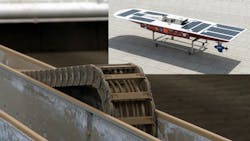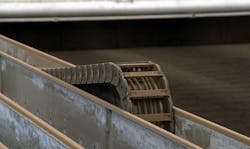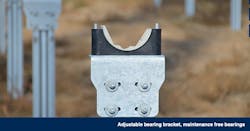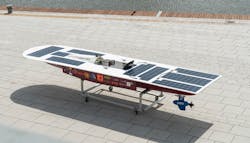Plastics Help Solar Power Reach Potential
As the world pushes ahead with demand for carbon-neutral technologies, the drive for developing solar-powered products is rapidly advancing. While many solar energy applications are well-known, engineers are just beginning to scratch the surface on the number of potential solar applications. The scope of the projects ranges between wastewater plants that are the largest in the world to trash bins that are about as big as an outdoor grill. Even more have yet to be discovered.
Many of these solar applications are including plastic components. Besides their self-lubricating properties, many engineers have discovered that such products extend service life, resist ultraviolet rays and are extremely lightweight. Officials at igus, the Germany-based manufacturer of motion plastics, believe the potential for more solar applications will emerge.
“We’re going to see products using solar energy continue to increase,’’ said Richard Won, igus’ Industry Manager for Renewable Energy. “The United States, especially, has huge potential. There are a lot of big companies in the U.S. doing business all over the world and they are figuring out different ways to use solar power.”
Solar and Wastewater
One of the most unusual applications centers on how solar energy is being used to manage wastewater in plants ranging from Egypt to Colombia to the United States. A unique system developed by HUBER uses solar energy in a sludge dryer that dramatically reduces the costs for sewage disposal.
The Bahr El-Baqar drainage canal in Egypt is considered one of the most polluted tributaries in the world. Industrial waste and sewage from Cairo, along with agricultural runoff, pesticides and fertilizers, end up flowing into the drain. Water quality scores range from 37-48, a rating that is marginal or poor. Much of the water is used for irrigation and fishing.
This is where the HUBER system has made a huge difference, The system includes 128 sludge turners and can accept approximately 490,000 tons of sludge per year. The system, which cost approximately $700 million, is constructed on more than 39 acres.
The SOLSTICE system from HUBER works in 16 greenhouses in the Egyptian system. The turner travels on rails and repeatedly rearranges the sludge on the ground. During the movement, the sludge is dried by solar energy. At the end of the drying lane, the sludge turner picks up the dry granules in the tool that repositions the sludge during its forward movement. The dry material is relocated to a recess in the ground, then collected and transported to a container.
While the Bahr El-Baqar system is the world’s largest, similar systems have been installed in Sanford, Fla. and Toole, Utah. In warm and cold climates, communities are turning to solar dryers to reduce sludge disposal costs and protect the environment.
Long Travel Energy Chains
The SOLSTICE units include self-lubricating and durable energy chains manufactured by igus. Besides those advantages, easy installation and maintenance of the e-chains were important factors for HUBER in the design of the system.
“Energy chains are the best solution for cable guidance on long travels,’’ said André Großer, HUBER SE product manager. “It requires little room, protects the cable and is easy to install and maintain.”
Engineers considered festoons but found the energy chains to be a better solution. “The problem with festoons is that the cables are always moving,” Großer said. “The movement puts stress on the strands and necessitates more maintenance than is the case with energy chains. The festoon also hangs in the air, causing obstruction, and its trolley takes up valuable space.”
The e-chains also contain igus chainflex cables, which provide dependable data transfer and energy supply. The energy chains were delivered with the cables already installed.
Three individual cores and a CFPE cable, all with a TPE outer jacket, ensure connection to the cable. Data exchange is with an igus CFBUS cable with a PUR outer jacket, and those cables are designed specifically for use in energy chains. They also include an abrasion-resistant outer jacket and special interior stranding.
Pre-assembly allowed for faster installation. With the cabling already in place, the number of suppliers was dramatically reduced and made on-site installation faster and easier. To reduce delivery costs, the fully equipped energy chains were placed on a drum and loaded into containers.
“This allowed us to save space and reduce shipment costs, and that was significant in a project of this size,’’ said Michael Offner of igus.
Pedestal Connects PV Platforms
An adjustable bearing consists of two half-shells made of plastic from igus—housing connected to the metal frame and an inner part mounted inside. The igus parts are made of lubricant-free and UV-resistant high-performance plastic that are extremely robust even when exposed to high temperatures or dirt. The upper part is a metal bracket manufactured by ZIMMERMANN. The division into a lower and an upper part allows for easy assembly and disassembly.
Despite its low overall weight, this solution is suitable for storing loads of up to 1.5 tons. Due to the overall structural design, the rows of solar panels in the ZIM Track System can be up to 96 meters long. The ZIMMERMANN PV trackers are located in Europe, Australia and South America.
Floating photovoltaic systems are more common overseas, where space for ground-mounted systems is in short supply. The National Renewable Energy Laboratory in the United States estimates photovoltaics could generate about 10 % of the nation’s annual electricity production.
Smaller Scale Projects, Too
Smaller project that also requires solar power still have significant needs.
A company in Finland, Finbin, developed a trash compactor that significantly reduces operating costs and the ecological footprint. The technology ensures that waste is compressed in a ratio of 6:1. The bins, approximately as tall as a standard outdoor grill, can hold over 1,200 liters of litter.
Engineers designed the units with plain bearings from igus for the hatch, pedal and pedal rods. The bearings are made with igus iglide G material, which are wear-resistant as well as resistant to dirt and dust. The bearings are used in a wide range of applications from medium to high loads, such as agricultural and other machines, automotive, and sports and leisure equipment.
The device illustrates the creativity with which engineers are working to develop more products that rely on solar power. There have been prior industrial revolutions, and it now seems the world is beginning a new one that relies on renewables. There are challenges, but there are also opportunities.
“There is no limit on what can be achieved through the use of solar energy,’’ Won said. “There are a lot of great innovations in the pipeline. Lubrication-free products that are resistant to dirt and dust, lightweight, durable and extensively tested are tremendously beneficial to any project that is looking to implement solar power.”
Solar Transportation Challenges Get Students Moving
By land and by water, solar energy is changing the way people go about their travel. Young and aspiring engineers, in particular, are helping to develop transportation equipment that runs on the sun.
Students founded the University of Minnesota Solar Vehicle Project in 1990, and three years later designed their first vehicle. Since then, the team has built 13 vehicles and raced in 30 solar challenges in three continents. The team finished second in a competition in August in a race from Independence, Mo. to Las Vegas that covered nearly 1,000 miles.
Students from Minnesota used the igus chainflex cables, while the boat includes iglide bearings in the steering assembly. The students took advantage of the lightweight and self-lubricating properties of the products.
The car designed by the students in Minnesota “is one of the most ambitious cars we’ve made in a while,’’ team member Shane Spangler said. ““The igus components were used in cabling for the solar panels and high-voltage BUS cables. The chainflex is very flexible and can get into very tight spaces.”
“A lot of companies in the United States are using solar power technology,’’ said Spangler. “My goal in life is to help impact climate change. I don’t see myself as a manager at a car company, but I do want to have an impact. Everything is going to need to be powered by renewable energy. We have to find ways to do that.”
Students in Poland’s Wroclaw University of Science and Technology developed a solar-powered boat. Wroclaw is the fourth largest city in Poland and offers some unique advantages for testing boats of any kind. Located on the Odra River, it is referred to as the “City of 100 Bridges,” as the river and its tributaries meander around 12 islands in Wroclaw.
The team from Poland used double flange iglide J bearings in the steering system. The bearings are lubrication-free and seawater-resistant. The bearing offers low wear at low to medium pressures, and also wears low against different shafts.
“igus bearings ensure long life,’’ said Dominika Dewor of the student boat team. “They reduce overall system weight, eliminate lubricants and are easy to install.”
Both teams were supported by the Young Engineers Support (YES) program, which gives students access to free and discounted product samples. The program is designed to foster the mechanical design ideas of students with a passion for engineering in high school or college. Students in the program have developed a wine storage product designed by students at Gsechs University of Applied Sciences in Hamburg.
Thomas Renner writes on engineering, building, construction, architecture and other trade industry topics for publications throughout the United States and Canada.



